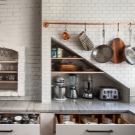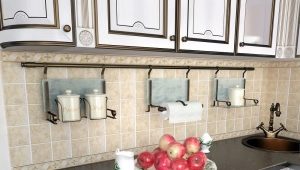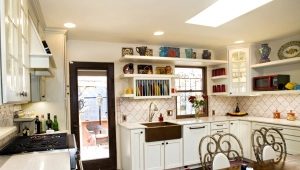How to install rails in the kitchen
What is a railing system
Not only what modern kitchen costs in our time without a railing system. The usual hollow tube with hooks on it turned out to be an indispensable assistant of housewives, and often is an ornament and attracts the attention of guests.
Rails as a system for organizing storage of kitchen utensils entered our houses from cafes and canteens. There they carried a functional load: the cooks had no time to search for and select the right pots, stewpans or knives on numerous shelves and in cabinets. Therefore, the location of kitchen tools in sight greatly simplified their task. Now, all lovers of the kitchen can appreciate all the advantages of railing.
Installing rails for a long time is not a sign of luxury. The basis of the railing is a hollow tube or a rod with a diameter of several centimeters, most often of stainless steel. It is attached to the wall with the help of holders, most often sold in the kit.After attaching the tube to it, hooks, shelves, and other elements, now presented in a wide variety, are hung on it. Depending on the size and type of construction, practically everything can be located on the railing - from the pepper shaker to the lid or even the pan.
Material railing system - the vast majority of stainless steel. It is able to withstand the effects of heat, steam, water and detergents without degrading properties and appearance. Railing elements can be painted, matted, imitate bronze or brass and support any style of the kitchen.
More rarely rails of aluminum, bronze and brass. Aluminum systems deform over time, and non-ferrous metal roof rails are expensive compared to steel ones, and they will not fit into any interior. Mostly they are found in luxury kitchens, made in a classic style.
If you decide to install rails in the kitchen, this will solve several problems at once:
- save space in kitchen furniture. Even in a large kitchen with an abundance of cabinets, it is sometimes difficult to allocate space for numerous spatulas, ladles, knives and chopping boards. Placing these items on the railing will free not one kitchen shelf;
- place the desired items in sight, thereby reducing the cooking time. In order for the railing system to be truly ergonomic, you should think in advance where and what is best to hang. For example, next to the stove, it would be logical to place the lids of pots and objects for stirring food while it is being cooked. And above the working surface of the table to set the shelf for cookbooks or spices;
- to give the kitchen an aesthetic look. Whatever style reigns in your kitchen - classic or high-tech - the manifold shapes and colors of the rail systems on the market are ready to blend in with the existing interior.
Types of designs
Horizontal
Horizontal railing most often can be seen in the kitchens of apartments and houses. The tube-bar is installed on the wall mounts along the kitchen apron or kitchen work area. After installing the crossbar, its ends are decorated with caps. The length of the crossbar depends on the length of the headset or the length of the wall along which the railing is installed. If the length is not enough, you can design a multi-tier system of horizontal rails, which exactly fit everything that you plan.
After installing the main crossbar, you can begin to hang the hooks. In addition to single, double and s-shaped hooks, there are many solutions for railings on the market: racks, shelves and various containers increase the effective area of the railing system. However, you should not post on railing everything. At hand should be the most necessary items or things that are often used during cooking or eating.
One of the varieties of horizontal railing is the corner option. Installation of an angular railing takes more time, however, there is a lot of benefit from it. For example, installing a suspension system in the corner where the sink is located will allow all detergents and sponges to be placed on the shelf, saving space near the sink.
Vertical
On the vertical rails, as a rule, heavier kitchen items are stored: cups, fruit boxes, vases, jars with cereals. Therefore, their design is more solid than horizontal. Vertical railing can occupy the entire height of the room, however, most often with its upper end it rests against the ceiling of the room, and the lower - into a bar table or tabletop.For the stability of the structure, an additional fastening to the wall is sometimes performed. Such rails create a special atmosphere of a home cafe and look very stylish in the interior.
Suspended
Suspended rail systems justify themselves when installed in large kitchens or with a large number of dishes for cooking. In this case, the railing is attached to the ceiling, most often above the kitchen island. It hangs all the necessary kitchen utensils - pots, ladles, stewpans. At the expense of it the considerable economy of the place in kitchen cases is reached. But to comply with the aesthetics of the cleanliness of the dishes will have to follow well.
How tall to hang
When planning the installation of the railing, you should consider the following recommendations:
- Placement of horizontal railing is advisable in the cooking zone. The rule may seem obvious, but you can often find horizontal bars installed in the area where the sockets are located. In this case, the railing is not just not used for its intended purpose, but may even become a hindrance to small household appliances (kettle, microwave, etc.);
- It is recommended to install a horizontal railing at a distance of 40-50 cm from the working surface, but not less than 5-7 cm from the hinged shelf.In general, the most functional is the installation scheme of the railing at the eye level of an adult. If the surface of the wall is lined with tiles, then the height of the installation of the railing can be selected taking into account the fastenings in the seam between the tiles;
- The best place to install vertical railing is the corner of the kitchen set. Thus, kitchen space will be used more efficiently. If the kitchen has a bar table - it is better to install a railing on it;
- The height of the suspension rail should be comfortable to use. That is, such that it is easy to remove heavy dishes from it and hang it back, but at the same time not to touch the pots and pans with your head. The kitchen island in rooms with high ceilings is considered the best for placing a suspended railing.
How to fix
Installing a horizontal railing with your own hands takes less than an hour. In addition to the acquired railing, to install it, you will need a small set of tools available in almost every home - a pencil, a hammer, a screwdriver, a perforator, screws, screws and concrete anchors. Often consumables (screws, screws) are already included in the kit of the railing system.
Installation of horizontal railing
On the wall into which the railing will be mounted, marks are made with a pencil for further drilling of holes. With these holes will be installed wall mounts. The optimal distance between the holes is 50 cm. With a distance between fastenings of more than 60 cm, the crossbar can deform under the weight of hanging utensils. For railing with a length of less than 1 m will be enough two holes.
After marking the holes, it is necessary to drill them, insert plastic dowels in them and carefully hammer them in with a hammer. Next, with the help of a self-tapping screw, bushings from the kit of the railing system are installed in the holes. On these sleeves the whole structure of the railing will be held, therefore it is important to pay special attention to this stage of work, having securely fastened the sleeves.
Wall holders are put on sleeves, and a crossbar is passed through them. For aesthetics, it is important to observe that at both ends of the crossbar protruding at the same distance from the holders. At the final stage, the position of the crossbar is fixed in the wall holders with the help of the screws included in the kit and a hex key.
Finishing work remained: wipe the railing, put the plugs on both sides and hang the hooks. It is worth considering that some designs of hooks and shelves are installed on the railing before the plugs. Thus, they can move along the railing between the two holders, but not removed from it.
If you follow the following simple rules, you can avoid installation errors.
- it is important to position the bar strictly horizontally. To do this, you can use the usual construction level and check the horizontal position during the marking of the holes;
- when drilling holes, a diamond-coated drill bit will prevent cracks and chips on the kitchen apron or tile. If it is possible to drill not the tile, but the inter tile space, it is better to use it. In the absence of the required tool, it is better to invite the master - his work will be cheaper than replacing a kitchen apron.
The installation diagram of the corner railing is a bit more complicated and is shown in the figure below. However, you can avoid the difficulties of acquiring an angled connector. It is a 90 ° curved section of the crossbar.Thus, the installation of the corner railing will not differ from the installation of a straight-line design.
How to hang fixtures on a horizontal railing is a matter of taste exclusively for every hostess. However, there are general recommendations on the location of objects on the railing:
- it is rational to fill the shelves above the sink with dishwashing liquids, sponges, and also provide hooks for towels or a holder for paper towels. You can also use the shelf as a dryer for dishes;
- the space above the stove is ideal for a shelf with spices, hooks with tacks and a kitchen lighter. And chrome ladles, spoons and skimmers should not be placed in such a place, because they will get dirty from fat when cooking dishes.
Vertical railing installation
The design of the vertical railing can be equipped with special struts. In this case, additional tools and consumables are not required. It is only necessary to follow the installation instructions, and then place the mounted shelves on the railing. In the absence of such struts, the technology of installing a vertical railing practically does not differ from the horizontal one: mark holes on the upper and lower surfaces of the fastening, drill them,insert dowels and secure the railing system with screws and screws.
Installation of mounted railing
First of all, when installing the mounted system, you should take care of its safety. As a result, reliable fixation with anchor bolts made in the form of a hook is necessary. The system is suspended with chains and is calculated in such a way as to withstand the weight of the structure itself and the weight of the kitchen utensils attached to it. It is better to entrust the installation and installation of mounted railing to professionals.




















































































